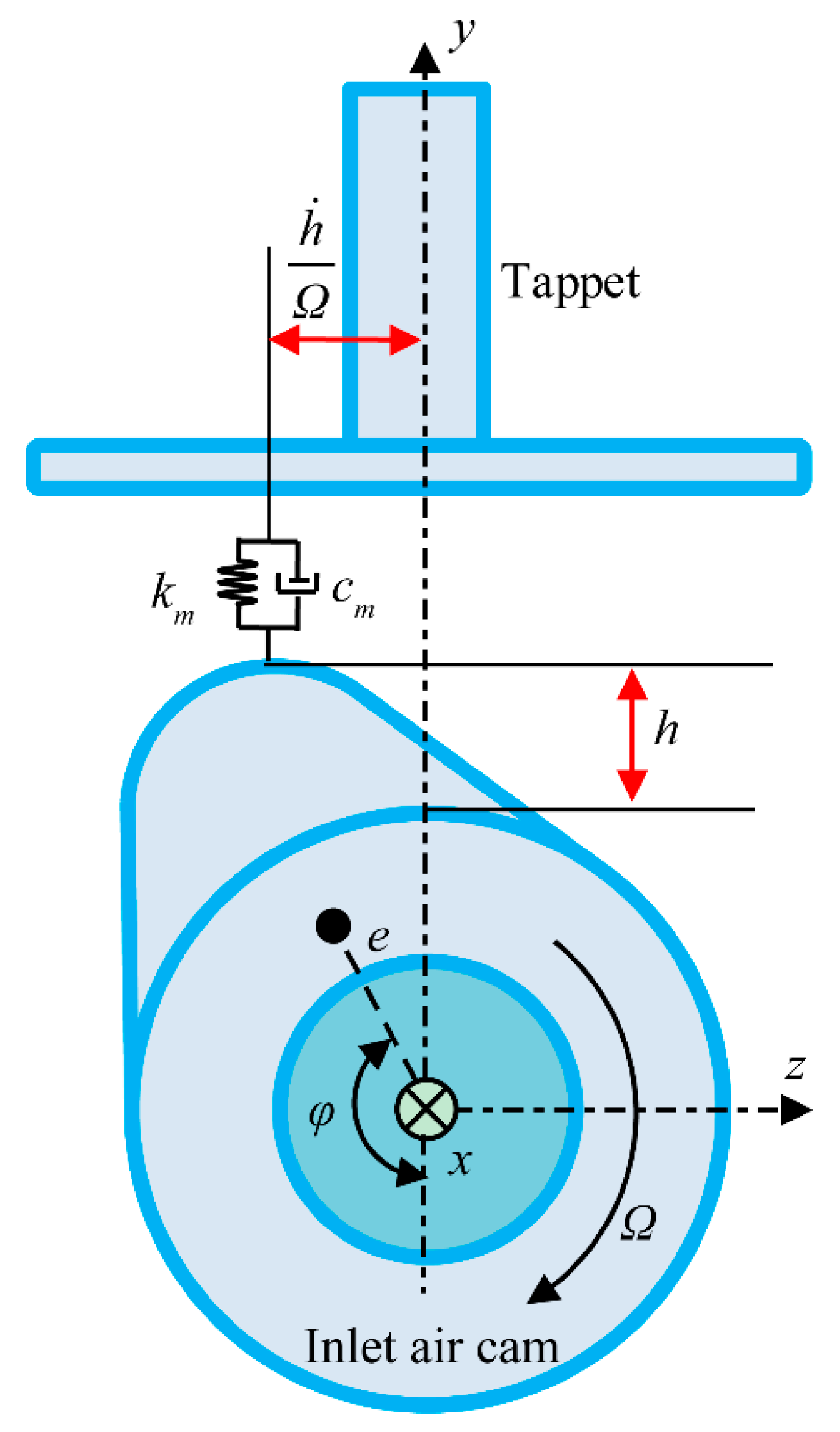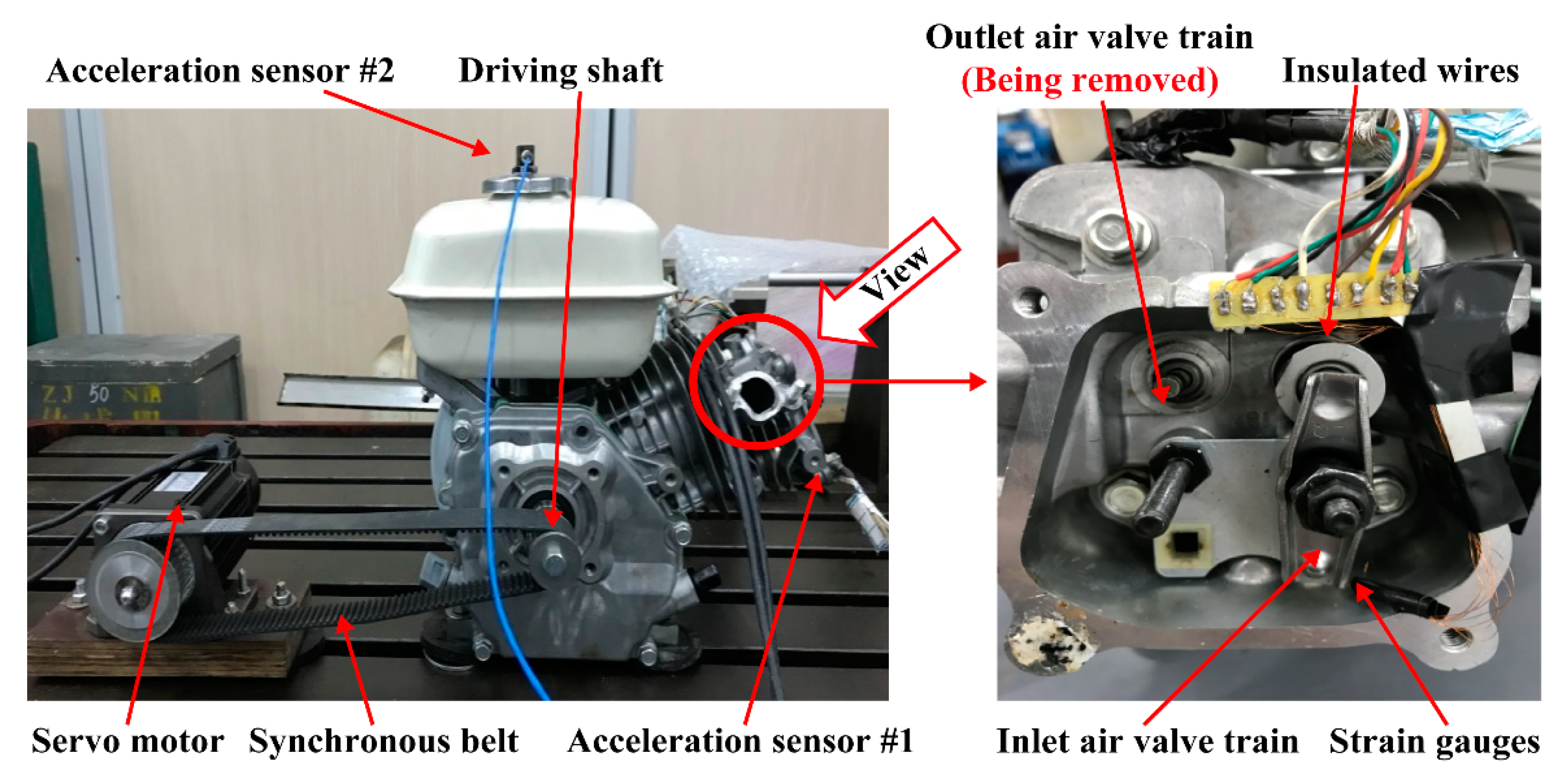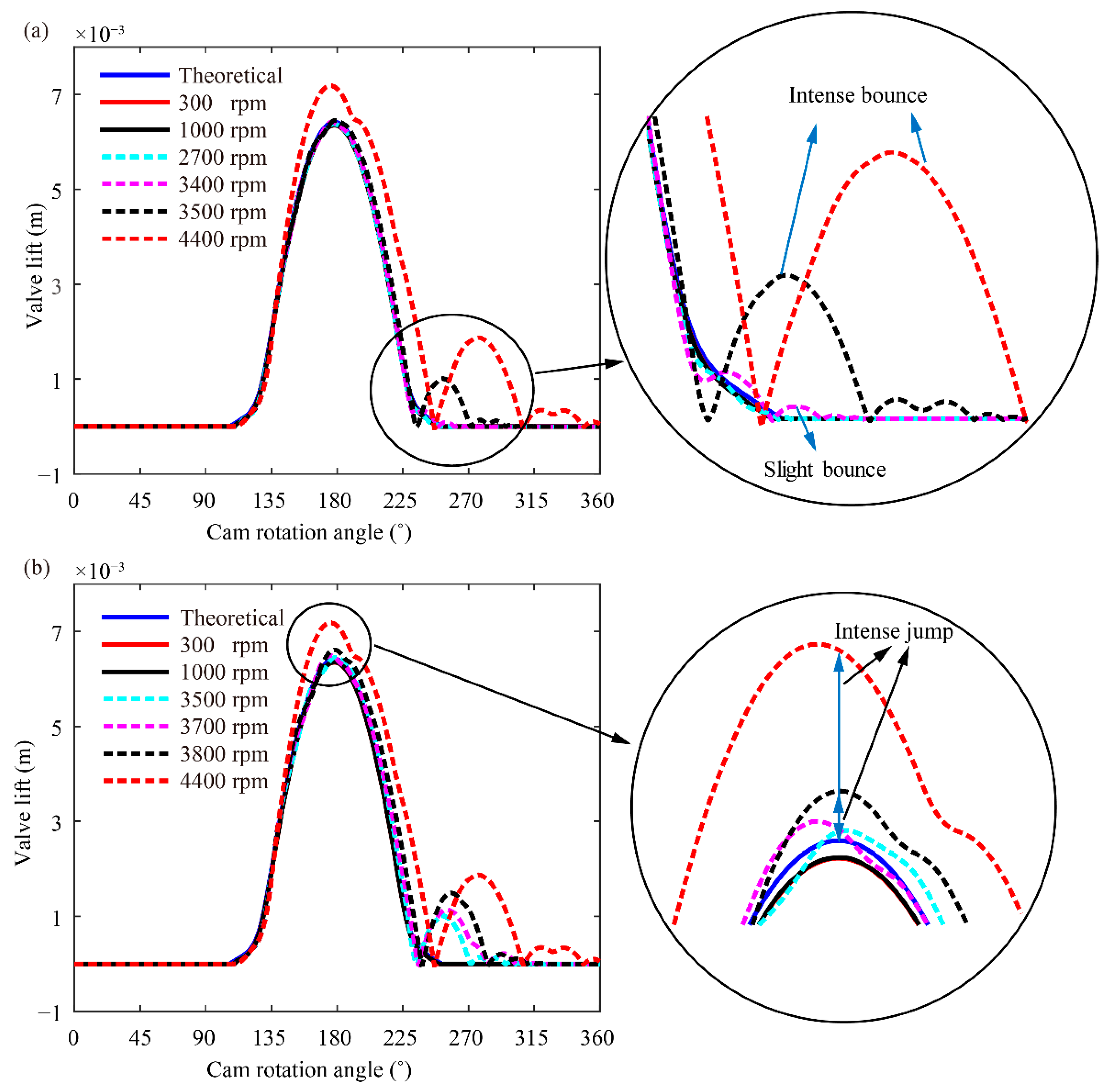Theoretical and Experimental Analysis of Dynamic Characteristics for a Valve Train System
Abstract
:1. Introduction
2. Dynamic Model
2.1. Flexible Shaft Element
2.2. Rotor Disc and Supporting Stiffness
2.3. Gear Meshing Formulations
2.4. Inlet Air Valve Train
2.5. Contact Formula of the Cam–Tappet Pair with Eccentricity
2.6. Dynamic Equations of the Valve Train System
3. Experimental Verification and Discussion
3.1. Housing Vibration
3.2. Pushrod Stress
3.3. Bounce and Jump
4. Conclusions
Author Contributions
Funding
Institutional Review Board Statement
Informed Consent Statement
Data Availability Statement
Conflicts of Interest
Nomenclature
| cm | Mesh damping of the gear pair |
| cc | Contact damping of the cam-tappet pair |
| este(t) | Static transmission error |
| fc | Cam centrifugal force |
| km | Mesh stiffness of the gear pair |
| kc | Contact stiffness of the cam-tappet pair |
| mc | The mass of the cam |
| mp | The mass of the pinion |
| mg | The mass of the gear |
| md | The mass of the disc |
| mi | The mass of ith element |
| q | Displacement vector of the overall DOF |
| qis | Displacement vector of the shaft element |
| qs | Displacement vector of arbitrary point on the shaft |
| qg | Displacement vector of the meshing gear pair |
| qid | Displacement vector of node i on the rotor disc |
| qik | Displacement vector of node i on the beam element |
| qib | Displacement vector of node i on the bar element |
| qc | Displacement vector of the cam-tappet pair |
| rbp | The base radius of the pinion |
| rbg | The base radius of the gear |
| ui | The ith DOF of the dynamic model |
| A | The cross-sectional area of the shaft element |
| B | The half of gear backlash |
| Cb | Damping matrix of the bearing |
| Cg | Damping matrix of the gear pair |
| Cc | Damping matrix of the cam-tappet pair |
| C | Overall damping matrix of the dynamic model |
| E | Young’s modulus of the material |
| Fis | Force matrix of the shaft element |
| Fid | Force matrix of the rotor disc |
| Fc | Contact force of the cam-tappet pair |
| Fc | Force matrix of the cam-tappet pair |
| F | Overall force matrix of the dynamic model |
| G | Overall gyroscopic matrix of the dynamic model |
| Gis | Gyroscopic matrix of the shaft element |
| Gid | Gyroscopic matrix of the rotor disc |
| JDs | Diameter mass moments of inertia of the shaft element |
| JPs | Polar mass moments of inertia of the shaft element |
| JDd | The moment of inertia about a diameter of the disc |
| JPd | The polar moment of inertia of the disc |
| JPp | The polar moment of inertia of the pinion |
| JDp | The moment of inertia about a diameter of the pinion |
| JDg | The moment of inertia about a diameter of the gear |
| JPg | The polar moment of inertia of the gear |
| JPc | The polar moment of inertia of the cam |
| JDc | The moment of inertia about a diameter of the cam |
| Kis | The stiffness matric of the shaft element |
| Kb | The stiffness matric of the ball bearing |
| Kg | Stiffness matrix of the gear pair |
| Kc | Stiffness matrix of the cam-tappet pair |
| K | Overall stiffness matrix of the dynamic model |
| Li | The length of ith element |
| Mis | Mass matrix of the shaft element |
| Mid | Mass matrix of the rotor disc |
| Mg | Mass matrix of the gear pair |
| Mc | Mass matrix of the cam-tappet contact |
| M | Overall mass matrix of the dynamic model |
| N | Shape function of the shaft element |
| αt | Transverse pressure angle |
| βb | Base helix angle |
| δm | Dynamic displacement of the meshing gear pair |
| δc | Dynamic deformation of the cam-tappet pair |
| μ | Friction coefficient of the cam-tappet pair |
| ρ | Material density of the shaft element |
| φ | Phase angle of the cam |
| φ0 | Initial phase angle of the cam |
| Ω | Spin speed of the shaft |
References
- Guo, J.; Cao, Y.; Zhang, W.; Zhang, X. Analysis of Engine Vibration and Noise Induced by a Valve Train Element Combined with the Dynamic Behaviors. J. Eng. Gas Turbines Power 2016, 138, 092806. [Google Scholar] [CrossRef]
- Hu, B.; Zhou, C.; Wang, H.; Yin, L. Prediction and validation of dynamic characteristics of a valve train system with flexible components and gyroscopic effect. Mech. Mach. Theory 2021, 157, 104222. [Google Scholar] [CrossRef]
- Teodorescu, M.; Votsios, V.; Rahnejat, H.; Taraza, D. Jounce and impact in cam-tappet conjunction induced by the elastodynamics of valve train system. Meccanica 2006, 41, 157–171. [Google Scholar] [CrossRef]
- Teodorescu, M.; Rahnejat, H. Mathematical modelling of layered contact mechanics of cam–tappet conjunction. Appl. Math. Model. 2007, 31, 2610–2627. [Google Scholar] [CrossRef]
- Paranjpe, R. Dynamic analysis of a valve spring with a coulomb-friction damper. J. Mech. Des. 1990, 112, 509–513. [Google Scholar] [CrossRef]
- Xuesong, M.; Youbai, X. A numerical analysis of the nonsteady EHL process in high-speed rotating engine cam/tappet pairs. J. Tribol. 1996, 118, 637–643. [Google Scholar] [CrossRef]
- Jelenschi, L.; Cofaru, C.; Sandu, G. Analyzing a direct acting valve train system. In 3rd WSEAS International Conference; MEQAPS: Sozopol, Bulgaria, 2011; pp. 11–13. [Google Scholar]
- Satyanarayana, M.; Dukkipati, R.V. Dynamic Response of Cam-Follower Mechanism; SAE Technical Paper No. 2009-01-1416; SAE: Warrendale, PA, USA, 2009. [Google Scholar]
- Huang, L.; Yin, L.; Liu, B.; Yang, Y. Design and Error Evaluation of Planar 2DOF Remote Center of Motion Mechanisms With Cable Transmissions. J. Mech. Des. 2021, 143, 013301. [Google Scholar] [CrossRef]
- Yu, J.; Luo, H.; Hu, J.; Nguyen, T.V.; Lu, Y. Reconstruction of high-speed cam curve based on high-order differential interpolation and shape adjustment. Appl. Math. Comput. 2019, 356, 272–281. [Google Scholar] [CrossRef]
- Luo, H.; Yu, J.; Li, L.; Huang, K.; Zhang, Y.; Liao, K. A novel framework for high-speed cam curve synthesis: Piecewise high-order interpolation, pointwise scaling and piecewise modulation. Mech. Mach. Theory 2021, 167. [Google Scholar] [CrossRef]
- Frendo, F.; Vitale, E.; Carmignani, L.; Gagliardi, D.; Matteucci, L. Development of a Lumped-Parameter Model for the Dynamic Analysis of Valve Train Systems; SAE Technical Paper NO. 2004-32-0051; SAE: Warrendale, PA, USA, 2004. [Google Scholar]
- Lee, J.; Patterson, D. Nonlinear valve train dynamics simulation with a distributed parameter model of valve springs. J. Eng. Gas Turbines Power 1997, 119, 692–698. [Google Scholar] [CrossRef]
- Guo, J.; Zhang, W.; Zou, D. Development and validation of a rigid–flexible coupled dynamic valve-train model. Proc. Inst. Mech. Eng. Part D J. Automob. Eng. 2012, 226, 94–111. [Google Scholar] [CrossRef]
- Qin, W.; Shen, J. Multibody System Dynamics Modelling and Characteristic Prediction for One Diesel’s Valve Train. In Proceedings of the 2009 Second International Conference on Information and Computing Science, Manchester, UK, 21–22 May 2009; IEEE: Manhattan, NY, USA, 2009; pp. 45–48. [Google Scholar]
- Yousuf, L.S. Experimental and simulation investigation of nonlinear dynamic behavior of a polydyne cam and roller follower mechanism. Mech. Syst. Signal Process. 2019, 116, 293–309. [Google Scholar] [CrossRef]
- Siczek, K.; Stefański, A. Analysis of dynamics and friction resistance in the cam-tappet system. J. Theor. Appl. Mech. 2019, 57, 273–286. [Google Scholar] [CrossRef]
- Rivola, A.; Troncossi, M.; Dalpiaz, G.; Carlini, A. Elastodynamic analysis of the desmodromic valve train of a racing motorbike engine by means of a combined lumped/finite element model. Mech. Syst. Signal Process. 2007, 21, 735–760. [Google Scholar] [CrossRef]
- Koster, M. Effect of flexibility of driving shaft on the dynamic behavior of a cam mechanism. J. Eng. Ind. 1975, 97, 595–602. [Google Scholar] [CrossRef]
- Kushwaha, M.; Rahnejat, H.; Jin, Z. Valve-train dynamics: A simplified tribo-elasto-multi-body analysis. Proc. Inst. Mech. Eng. Part K J. Multi-Body Dyn. 2000, 214, 95–110. [Google Scholar] [CrossRef] [Green Version]
- Teodorescu, M.; Kushwaha, M.; Rahnejat, H.; Taraza, D. Elastodynamic transient analysis of a four-cylinder valvetrain system with camshaft flexibility. Proc. Inst. Mech. Eng. Part K J. Multi-Body Dyn. 2005, 219, 13–25. [Google Scholar] [CrossRef] [Green Version]
- Carlini, A.; Rivola, A. A nonlinear elastodynamic model of a camshaft supported by journal bearings. In Proceedings of the AIMETA’03–16th AIMETA Congress of Theoretical and Applied Mechanics, Ferrara, Italy, 9–12 September 2003; pp. 9–12. [Google Scholar]
- Tounsi, M.; Chaari, F.; Walha, L.; Fakhfakh, T.; Haddar, M. Dynamic behavior of a valve train system in presence of camshaft errors. Wseas Trans. Theor. Mech. 2011, 1, 17–26. [Google Scholar]
- Guo, J.; Zhang, W.; Zou, D. Investigation of dynamic characteristics of a valve train system. Mech. Mach. Theory 2011, 46, 1950–1969. [Google Scholar] [CrossRef]
- Nelson, H. A finite rotating shaft element using Timoshenko beam theory. J. Mech. Des. 1980, 102, 793–803. [Google Scholar] [CrossRef]
- Hu, B.; Zhou, C.; Wang, H.; Chen, S. Nonlinear tribo-dynamic model and experimental verification of a spur gear drive under loss-of-lubrication condition. Mech. Syst. Signal Process. 2021, 153, 107509. [Google Scholar] [CrossRef]
- Chen, S.; Tang, J.; Li, Y.; Hu, Z. Rotordynamics analysis of a double-helical gear transmission system. Meccanica 2016, 51, 251–268. [Google Scholar] [CrossRef]
- Hu, Z.; Tang, J.; Zhong, J.; Chen, S.; Yan, H. Effects of tooth profile modification on dynamic responses of a high speed gear-rotor-bearing system. Mech. Syst. Signal Process. 2016, 76, 294–318. [Google Scholar] [CrossRef]
- Wan, Z.; Cao, H.; Zi, Y.; He, W.; Chen, Y. Mesh stiffness calculation using an accumulated integral potential energy method and dynamic analysis of helical gears. Mech. Mach. Theory 2015, 92, 447–463. [Google Scholar] [CrossRef]
- Hu, B.; Zhou, C.; Chen, S. Elastic dynamics modelling and analysis for a valve train including oil film stiffness and dry contact stiffness. Mech. Mach. Theory 2019, 131, 33–47. [Google Scholar] [CrossRef]
- Zhou, C.; Hu, B.; Chen, S.; He, L. An enhanced flexible dynamic model and experimental verification for a valve train with clearance and multi-directional deformations. J. Sound Vib. 2017, 410, 249–268. [Google Scholar] [CrossRef]









| Element No. | Diameter (mm) | Length (mm) | Element No. | Diameter (mm) | Length (mm) | Element No. | Diameter (mm) | Length (mm) |
|---|---|---|---|---|---|---|---|---|
| Driving shaft | Camshaft | Inlet air valve train | ||||||
| ➀ | 25.00 | 13.00 | ➇ | 12.00 | 6.20 | ⑯ | 8.00 | 30.50 |
| ➁ | 25.00 | 13.00 | ➈ | 14.00 | 10.20 | ⑰ | 4.00 | 67.00 |
| ➂ | 30.00 | 11.00 | ⑩ | 14.60 | 12.85 | ⑱ | 4.00 | 67.00 |
| ➃ | 14.00 | 18.71 | ⑪ | 14.60 | 13.35 | ⑲ | 6.50 | 26.67 |
| ➄ | 14.00 | 18.71 | ⑫ | 14.60 | 15.70 | ⑳ | 6.50 | 30.67 |
| ➅ | 14.00 | 18.71 | ⑬ | 14.60 | 15.90 | ㉑ | 5.50 | 32.00 |
| ➆ | 12.00 | 18.71 | ⑭ | 14.60 | 16.78 | ㉒ | 5.50 | 32.00 |
| ⑮ | 12.00 | 11.26 | ||||||
| Bearings Stiffness | Bearing #1 and #2 | Bearing #3 and #4 | Joint |
|---|---|---|---|
| kxx (N/m) | 6.8 × 107 | 4.1 × 107 | 1.1 × 108 |
| kyy (N/m) | 6.8 × 107 | 4.1 × 107 | 1.1 × 108 |
| kzz (N/m) | 5.4 × 106 | 1.9 × 107 | 1.1 × 106 |
| kθxθx (N/rad) | 2.1 × 103 | 1.9 × 103 | / |
| kθyθy (N/rad) | 2.1 × 103 | 1.9 × 103 | / |
| kxθy,kyθx,kθxy,kθyx (N/rad) | 3.7 × 105 | 2.8 × 105 | / |
| c (Ns/m) | 1.0 × 103 | 1.0 × 103 | 1.0 × 103 |
| Parameters | Values | Parameters | Values |
|---|---|---|---|
| m (mm) | 1.75 | JPp (kg∙m2) | 2.13 × 10−5 |
| mp (kg) | 6.00 × 10−2 | JPg (kg∙m2) | 3.51 × 10−4 |
| mg (kg) | 3.61 × 10−1 | Rp (mm) | 21.74 |
| zp | 24 | Rg (mm) | 43.48 |
| zg | 48 | αn (°) | 20 |
| JDp (kg∙m2) | 1.12 × 10−5 | β (°) | 15 |
| JDg (kg∙m2) | 1.77 × 10−4 | ζ | 0.07 |
| Cam Rotation Speed | Bounce Phenomenon | Jump Phenomenon |
|---|---|---|
| 300 rpm | No bounce | No jump |
| 1000 rpm | No bounce | No jump |
| 2700 rpm | No bounce | No jump |
| 3400 rpm | Slight bounce | No jump |
| 3500 rpm | Intense bounce | Slight jump |
| 3700 rpm | Intense bounce | Slight jump |
| 3800 rpm | Intense bounce | Intense jump |
| 4400 rpm | Intense bounce | Intense jump |
Publisher’s Note: MDPI stays neutral with regard to jurisdictional claims in published maps and institutional affiliations. |
© 2021 by the authors. Licensee MDPI, Basel, Switzerland. This article is an open access article distributed under the terms and conditions of the Creative Commons Attribution (CC BY) license (https://creativecommons.org/licenses/by/4.0/).
Share and Cite
Hu, B.; Li, Y.; Yin, L. Theoretical and Experimental Analysis of Dynamic Characteristics for a Valve Train System. Sensors 2021, 21, 6328. https://doi.org/10.3390/s21196328
Hu B, Li Y, Yin L. Theoretical and Experimental Analysis of Dynamic Characteristics for a Valve Train System. Sensors. 2021; 21(19):6328. https://doi.org/10.3390/s21196328
Chicago/Turabian StyleHu, Bo, Yunzhe Li, and Lairong Yin. 2021. "Theoretical and Experimental Analysis of Dynamic Characteristics for a Valve Train System" Sensors 21, no. 19: 6328. https://doi.org/10.3390/s21196328




